Mayor Shari Cantor: West Hartford’s Success ‘Is No Accident,’ It’s Continuous Hard Work and Dedication

Audio By Carbonatix

West Hartford Mayor Shari Cantor delivers her State of the Town address March 3 at the Mandell JCC. Photo credit: Manon Mirabelli
West Hartford Mayor Shari Cantor delivered her annual State of Town Address Monday evening at an event hosted by the Chamber of Commerce.
By Manon L. Mirabelli
Mayor Shari Cantor gave the State of the Town Address March 3 to a crowd of business leaders, town staff, and other members of the community at the Mandell JCC, and assured citizens that West Hartford continues to be a prosperous community that is welcoming exciting initiatives as it ushers in a new era of growth.
“I am proud to report that the state of West Hartford is incredibly strong.” she said. “But our success is no accident. It is the result of generations of hard work – a continuous effort by those who dedicate themselves to something larger than themselves.”
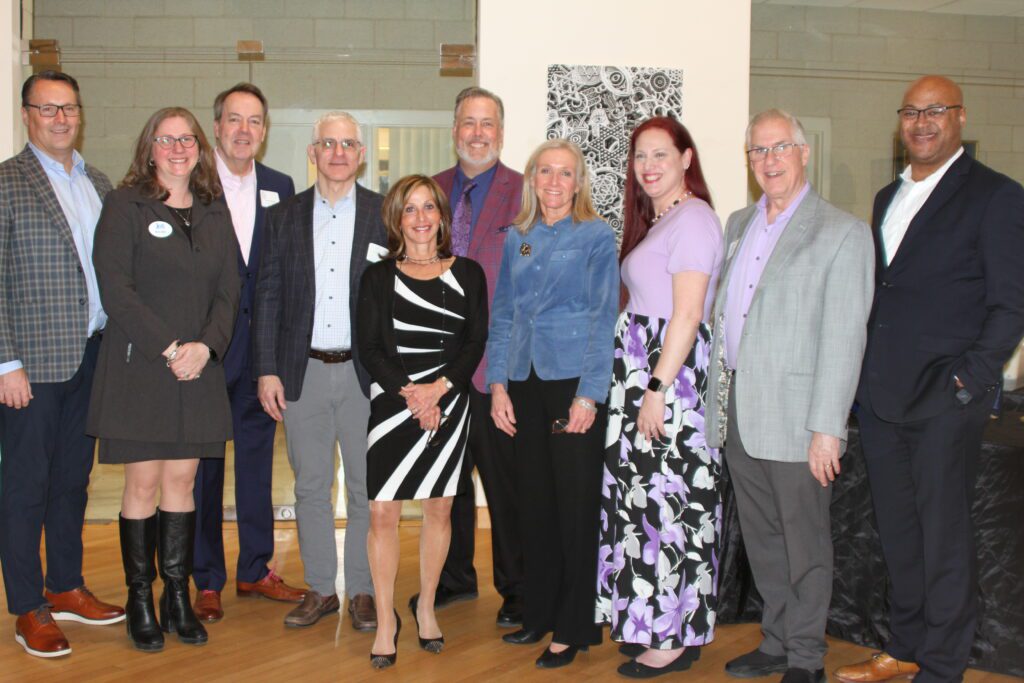
Chamber of Commerce leaders and members join Mayor Shari Cantor at the Mayor’s State of the Town Address on March 3 at the Mandell JCC. From left: Brett Bushnell, Rachel Stein, Chuck Coursey, Andreas Kapetanopoulous, Mayor Shari Cantor, Chris Conway, Rhona Free, Kate Kobs, Chip Janiszewski, and Chris Clarke. Photo credit: Manon Mirabelli
A Growing Grand List
West Hartford’s Grand List grew by $8.5 million in 2024 for a net total of $7.2 billion, an increase seen despite a $50 million decrease in motor vehicle value due to a new state law change that significantly recalculated the methodology of assessing motor vehicles.
“The House and Senate have recently approved an option that would reverse this change, which would result in a significant increase in our Grand List this year, further demonstrating our strong economic foundation,” Cantor said. “If approved, this total is expected to go up when the Town Council votes on the annual town budget in April.”
Cantor cited several industries that experienced much growth in West Hartford. These included risk management and insurance, financial services, legal professionals, and manufacturing.
“Many businesses and restaurants opened this past year, and some focused on unique experiences, from hands-on pottery classes to yoga for kids,” she noted.
Diversity Driving Development
From welcoming new business to town to the development of affordable housing, each faction of West Hartford’s diverse population will be served with equal vigor, Cantor added.
She also described residents and town officials as supportive of the community at-large citing town-wide participation in the library’s annual Kindness Project, West Hartford United Methodist Church toiletry and diaper drive, and the 30th Annual Morley Elementary School Red Wagon Food Drive, as well as the Able Table in Blue Back Square – a public art piece, and a picnic table designed for accessibility.
“Our community is vibrant, diverse, and caring,” Cantor said. “We support and care for each other. No matter who you love, what you believe, where you come from, or how you identify, we are a welcoming community for all.”
Although speaking in particular about education when giving the following statistics, Cantor pointed out the myriad cultures within the town’s diverse population that are driving change.
“Twenty-seven percent of our students are non-English speakers representing 71 languages, 29% qualify for free or reduced meals, and 17% receive special education services,” the mayor noted.
In meeting the needs of an increasingly diverse population, the mayor also pointed to the leveraging of the state’s Brownfield grant program to redevelop underutilized properties like the Elmwood Lofts and The Elle, for example, as turning eyesores into “thriving community assets.”
“We have made affordability a top priority, ensuring that all new residential developments include affordable housing options,” Cantor said.
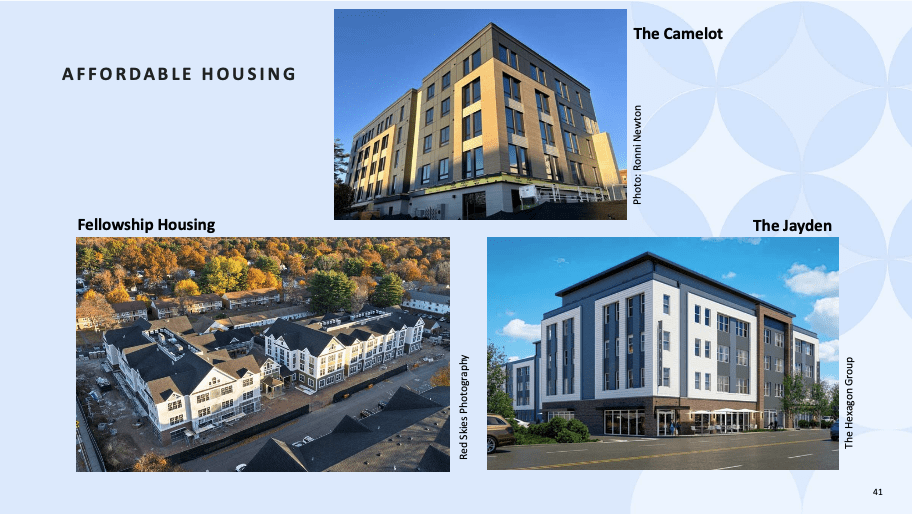
Screenshot from Mayor’s State of the Town Address. Courtesy image
Other examples of affordable and accessible housing include West Hartford Fellowship Housing and The Camelot, while diverse housing options that include at least some affordable units include transit-oriented development at The Jayden, and the eastern portion of the former UConn campus which will become the Residences at Heritage Park.
In addition to Brownfield grants, she said, many West Hartford projects have been funded by other sources such as the American Rescue Plan Act, Sustainable CT Match Fund, and State Bond Commission awards.
The transformative and long-awaited redevelopment of the former University of Connecticut campus, which received its final approval just last week, is a prime example of a partnership that will result in the improvement of wetlands and the expansion of the Trout Brook Trail as well as residential and commercial development, Cantor noted.
“This public-private partnership will create new housing, commercial space, and deed-restricted public green space while improving traffic flow and connectivity.”
Award-Winning Public School System
Cantor told those gathered at the JCC that a key factor in attracting more residents and business to West Hartford is the town’s top-notch public school system that has earned statewide and national accolades.
“Our schools are a source of immense pride and a primary reason so many young families choose to call West Hartford home,” Cantor said. “Conard and Hall High schools rank in the top 3% of public high schools nationwide, earning “Gold Medal” status on the AP School Honor Roll.”
In addition, Bugbee Elementary School was recently ranked among the top 10 schools in Connecticut by U.S. News & World Report.
“All of this is accomplished with very efficient per-pupil spending ratios for our state,” Cantor noted.
Smart Growth and Development
Demand for space in West Hartford far outpaces supply, Cantor said, confirming that occupancy levels are greater than 94%, with 6,707 active registered businesses.
“To ensure retention and assist with expansion, our Economic Development team made more than 350 visits in 2024,” she said. “As a nearly fully developed town, we have worked creatively to support smart, sustainable growth and encouraged responsible development through policies that promote affordability, green space, and infrastructure improvements.”
The Chamber of Commerce hosted the annual Economic Development luncheon in January, highlighting many of those successes.
Responsible Fiscal Leadership
“Transparency, accountability, and fiscal responsibility remain bedrock principles of our town government,” Cantor said.
Businesses, she asserted, choose where to locate based on a community’s long-term financial health, which affects everything from property taxes to the reliability of essential services.
“While some governments rely on budgetary gimmicks, we have focused on responsible, reality-based budgeting,” she said. “As a result, West Hartford’s financial position is the strongest it has ever been.
We have the highest fund balance in our history, a nearly fully funded pension plan, and a AAA bond rating, allowing us to invest in capital projects at the lowest possible cost.”
Cantor outlined examples of the town’s capital investments to include park improvements to baseball and softball fields, basketball courts, restroom buildings, and the addition of a new pickleball court.
In addition, a new Animal Control facility that meets all of the state’s new regulations and a new fuel depot station and material solution center at Public Works are in the making, as well as school security improvements at Wolcott and King Philip, a new modern fire department training tower and training site, and plans that are progressing for the new Elmwood Community Center.
“By investing in our community, this approach has driven property values up and spurred new development,” Cantor stated. “In 2024 alone, our building department processed nearly 600 more permits than in 2023. One Park alone had more than 1,500 permits.”
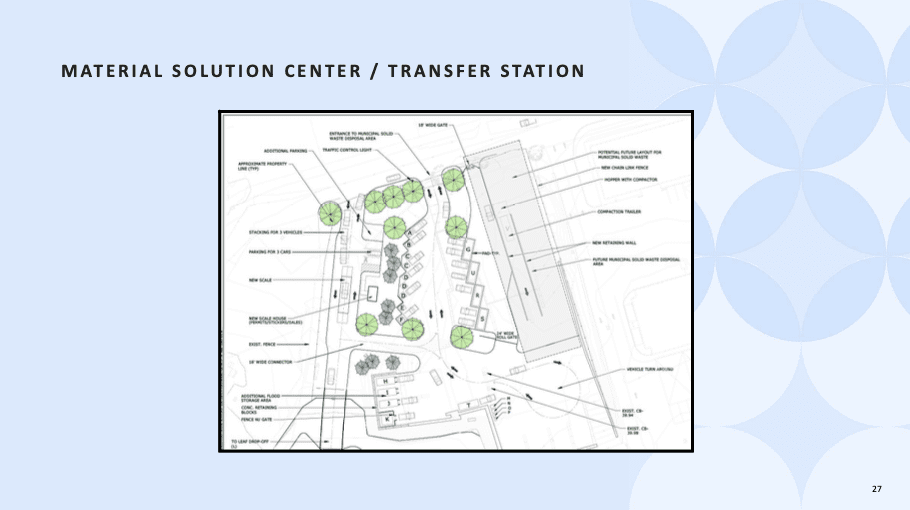
Screenshot from Mayor’s State of the Town Address. Courtesy image
A Competitive Real Estate Market
In January 2025, the median listing home price in West Hartford was $454,900, representing an 11% year-over-year increase. The median home sold for $475,000, and on average, homes sell after 25 days on the market, just a slight decrease from last year.

From left, Jen Bucari, Alison Overholt, and Rob Giuffria, all of Tea Leaf Realty, at the Mayor’s State of the Town address March 3 at the Mandell JCC. Photo credit: Manon Mirabelli
Public Transportation Key to a Thriving Community
“Investments in West Hartford’s Transit-Oriented Development are very important to our thriving community,” Cantor said. “Both the Elmwood Lofts and the Jayden are welcome additions to the New Park Avenue and New Britain Avenue areas.”
But with those additions comes the increased need for reliable public transportation, the mayor said.
In a recently released, five-year transportation infrastructure capital plan, the state Department of Transportation calls for a West Hartford train station at 285 Newfield Avenue in the Elmwood neighborhood near one of the town’s existing CTfastrak stations.
“The project, which has an estimated cost of $70.5 million, would include the construction of two platforms and a parking lot, as well as improvements to the Flatbush Avenue bus station,” Cantor said. “This would be a big boost to the business district.”
Before they can do that, though, the DOT needs to finish its double-tracking project in West Hartford, Hartford, Windsor, Windsor Locks, and Enfield, which is key to enabling expansion, Cantor added.
Traffic Safety Projects Completed in 2024
With the completion of the Trout Brook Trail will come the expansion of sidewalks, bike paths, and pedestrian-friendly infrastructure, Cantor said, “transforming how residents move through town.”
“As we grow, we must ensure safe, accessible streets,” she said, which calls for advancing Vision Zero, a policy aimed at eliminating traffic fatalities and reducing speeds throughout town.
West Hartford was the first town in the state to adopt a Vision Zero Plan a year ago.
“We have collected data and identified the high-injury network locations as a priority,” Cantor said. “Substantial progress has been made toward advancing Vision Zero in 2024.”
In total, 115 separate projects were accomplished last year due to a $1 million American Rescue Plan Act allocation through the Connecticut State Legislature, and many more projects are either ongoing or new for 2025.
Also implemented in 2024 were traffic safety projects that included raised crosswalks, speed tables, flashing beacons, rumble lanes, improved street lighting, road diets, the removal vegetation for better sight line visibility, improved lane configurations, and signage to reduce speeds and improve safety for all road users.
“We are currently working on a driver pledge to make people take full responsibility for road safety when they sit behind the wheel of a car,” Cantor said.
Cantor said West Hartford has been awarded and received funding from a federal Safe Streets for All grant to install 15 automated speed enforcement cameras across town.
“A second, $3.1 million grant, which we received approval for to make many road safety improvements, is currently held up at the federal level,” she explained. Included in that grant is funds for a red light camera enforcement program.
In order to move forward with the automated traffic safety devices, the town, must adopt an ordinance and submit it along with data backing up the choice of locations. “I will strongly urge my colleagues to adopt an ordinance making West Hartford one of the first towns in Connecticut to implement speed cameras – one of the most effective ways to reduce speeds and improve pedestrian safety,” Cantor said.
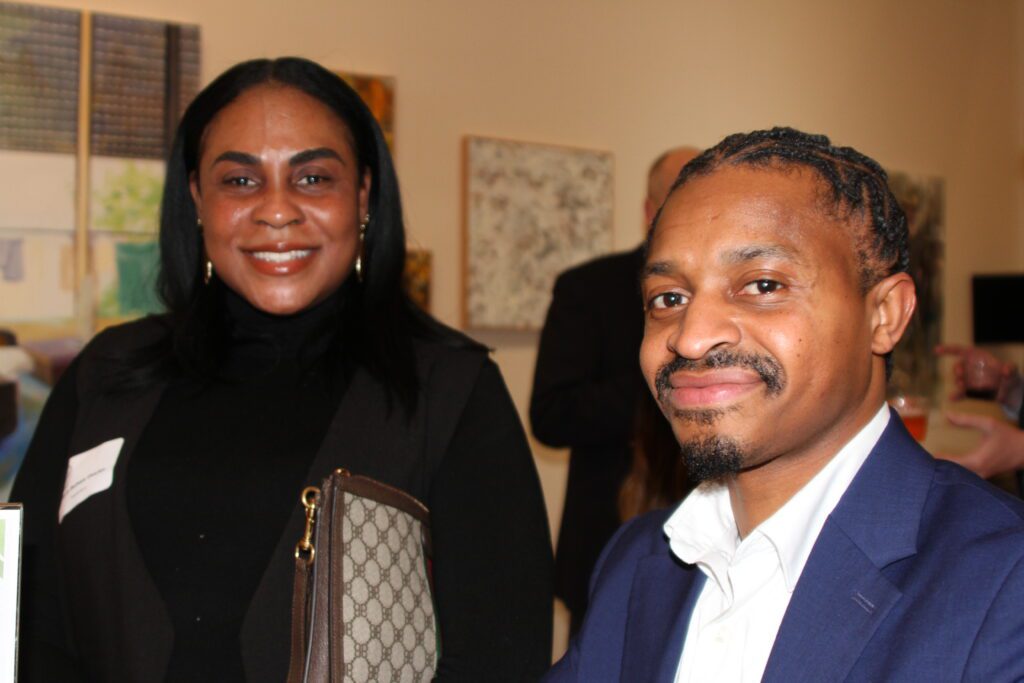
Mavis Durham Charles and Kevin Brissett at the reception following the Mayor’s State of the Town address March 3 at the Mandell JCC. Photo credit: Manon Mirabelli
Road Safety Audit in the Making
A Road Safety Audit is an important planning tool for future road improvements, Cantor said, and noted that one was completed on Park Road in preparation for the road rehabilitation project that will begin this summer with another RSA planned for Sedgwick Road in the fall
“The Department of Transportation did one on Albany Avenue in preparation of developing plans to improve pedestrian mobility and overall traffic flow at the intersection of Albany Avenue at North Main Street,” she said.
The construction cost will be paid with 80% federal and 20% stare funds. Construction in Bishops Corner is anticipated to start in 2027.

From left, Roseanne Horn, Michael Cantor, Mayor Shari Cantor, Jim Carroll, and Steve Litchfield at the reception following the Mayor’s State of the Town address March 3 at the Mandell JCC. Photo credit: Manon MIrabelli
Sustainability and Renewable Energy
“We are also committed to sustainability in all we do,” she said, adding that Connecticut faces a trash crisis, and “we are leading efforts to reduce waste” by expanding food waste diversion in schools, and launching free, organic waste drop-off locations for residents this spring.
Sustainable CT also named West Hartford a climate leader and, in 2024, the town became one of six gold certified communities.
“West Hartford has achieved a remarkable milestone in renewable energy adoption through a strategic combination of renewable energy credit purchases, on-site solar installations, and virtual net metering,” Cantor said, “The town has exceeded its goal of powering municipal buildings with 100% renewable energy.”
In addition, the town completed a tree canopy study and planted more than one thousand young, healthy native trees through the West Hartford Tree Project, which is funded in part through the Sustainable CT Match Grant program and “powered by dedicated volunteers, and supported by the expertise of staff from Leisure Services, Public Works, and West Hartford Public Schools.”
West Hartford – A Thriving Community
Cantor framed much of her address on the concept of “The Let Them Theory,” the theme of a book by Mel Robbins, and a concept which encourages people not to try to control others but rather to focus on “the importance of exercising control over what we can and therefore taking action at the local level.”
West Hartford is already an engaged community. “Citizen participation is the foundation of representative democracy,” she said.
In closing, Cantor said the accomplishments achieved last year and the ones to come are the product of the collaboration of community officials and residents who work toward making West Hartford a model for the progressive, yet historical ideals on which it continues to build.
“West Hartford is thriving,” she said, “not because of luck but because of the tireless efforts of those like you and so many others who have dedicated themselves to this community.”
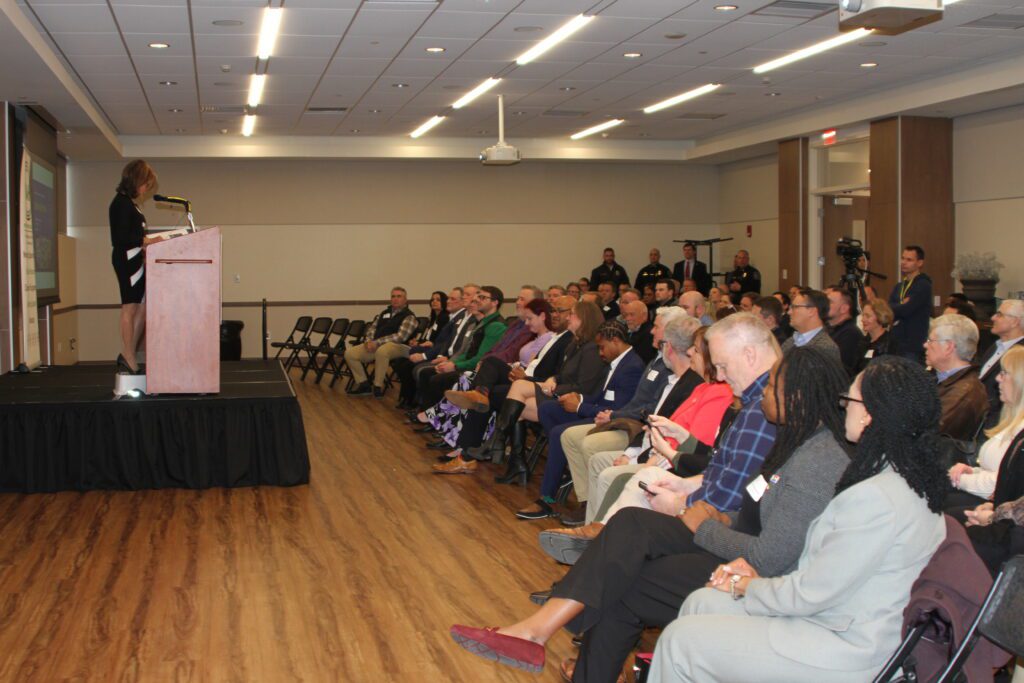
West Hartford officials, members of the business community, and residents gather at the Mandell JCC March 3 to hear Mayor Shari Cantor’s State of the Town address. Photo credit: Manon Mirabelli
Like what you see here? Click here to subscribe to We-Ha’s newsletter so you’ll always be in the know about what’s happening in West Hartford! Click the blue button below to become a supporter of We-Ha.com and our efforts to continue producing quality journalism.



